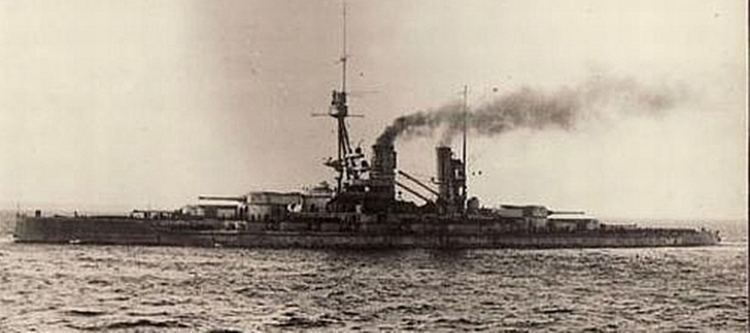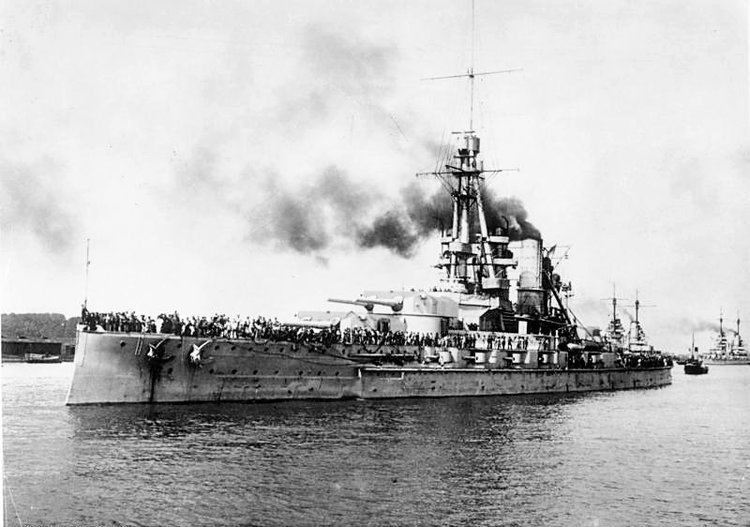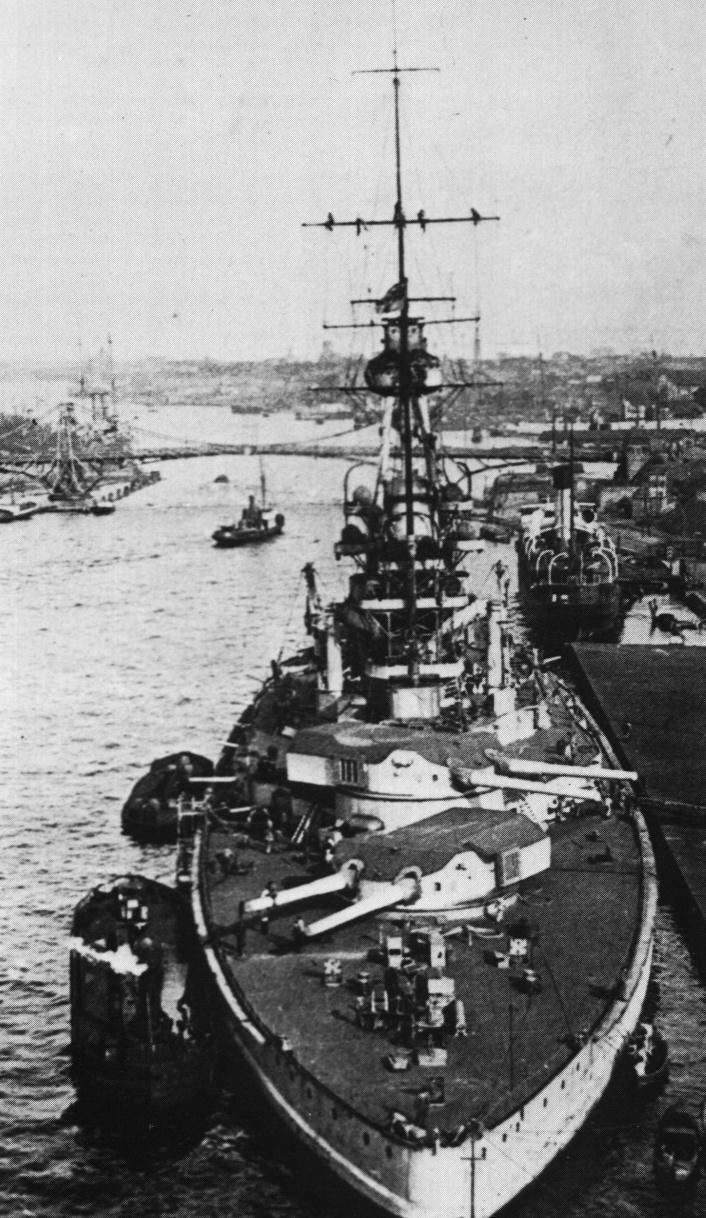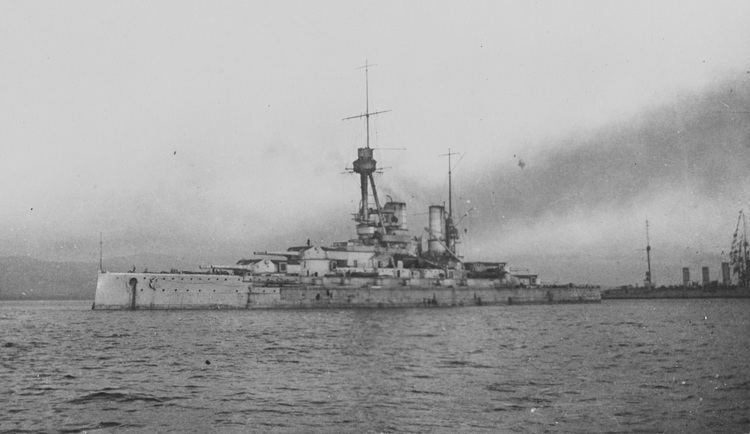Name SMS Bayern Commissioned 15 July 1916 Construction started 20 August 1913 Weight 32,200 tons | Laid down 20 August 1913 Length 180 m Launched 18 February 1915 Beam 30 m | |
 | ||
Builder Howaldtswerke-Deutsche Werft | ||
SMS Bayern was the lead ship of the Bayern class of battleships in the German Kaiserliche Marine (Imperial Navy). The vessel was launched in February 1915 and entered service in July 1916, too late to take part in the Battle of Jutland. Her main armament consisted of eight 38 cm (15 in) guns in four turrets, which was a significant improvement over the preceding König's ten 30.5 cm (12 inch) guns. The ship was to have formed the nucleus for a fourth battle squadron in the High Seas Fleet, along with three of her sister ships. Of the other ships only one—Baden—was completed; the other two were canceled later in the war when production requirements shifted to U-boat construction.
Contents

Bayern was commissioned midway through the war, and had a limited service career. The first operation in which the ship took part was an abortive fleet advance into the North Sea on 18–19 August 1916, a month after she had been commissioned. The ship also participated in Operation Albion in the Gulf of Riga, but shortly after the German attack began on 12 October 1917, Bayern was mined and had to be withdrawn for repairs. She was interned with the majority of the High Seas Fleet in Scapa Flow in November 1918 following the end of World War I. On 21 June 1919, Admiral Ludwig von Reuter ordered the fleet to be scuttled; Bayern sank at 14:30. In September 1934, the ship was raised, towed to Rosyth, and scrapped.

Design

Bayern was 179.4 m (588 ft 7 in) long at the waterline, and an even 180 m (590 ft 7 in) long overall. She had a beam of 30 m (98 ft 5 in) and a draft of 9.3–9.4 m (30 ft 6 in–30 ft 10 in) Bayern displaced 28,530 metric tons (28,080 long tons) at a normal displacement; at full combat load, she displaced up to 32,200 t (31,700 long tons). Bayern was powered by three Parsons steam turbines rated at 34,521 shaft horsepower (25,742 kW) and three oil-fired and eleven coal-fired Schulz-Thornycroft boilers, and on trials achieved 55,202 shaft horsepower (41,164 kW); she had a maximum speed of 22 knots (41 km/h; 25 mph). The ship could carry up to 3,400 t (3,300 long tons; 3,700 short tons) of coal and 620 t (610 long tons; 680 short tons) of fuel oil, which provided a maximum range of 5,000 nmi (9,300 km; 5,800 mi) at a cruising speed of 12 kn (22 km/h; 14 mph).

The ship was the first German warship armed with eight 38 cm (15 in) guns. The main battery guns were arranged in four twin gun turrets: two superfiring turrets each fore and aft. Her secondary armament consisted of sixteen 15 cm (5.9 in) guns, six 8.8 cm (3.45 in) guns and five 60 cm (23.6 in) underwater torpedo tubes, one in the bow and two on each beam. Upon commissioning, she carried a crew of 42 officers and 1,129 enlisted men. The ship had an armored belt that was 170–350 mm (6.7–13.8 in) thick and an armored deck that was 60–100 mm (2.4–3.9 in) thick. Her forward conning tower had 400 mm (16 in) sides, and the main battery turrets had 350 mm thick sides and 200 mm (7.9 in) thick roofs.
Service history

Bayern was ordered with the provisional name "T" in 1912, under the fourth and final Naval Law, which was passed that year. Work began at the Howaldtswerke Dockyard in Kiel under construction number 590. The ship was laid down in 1913 and launched on 18 February 1915. After fitting-out and sea trials, the ship was commissioned on 15 July 1916, a month and a half too late for her to participate in the Battle of Jutland. Bayern joined the III Battle Squadron of the High Seas Fleet upon her commissioning. The ship would have been available for the operation, but the ship's crew, composed largely of the crew from the recently decommissioned battleship Lothringen, was given leave. She had cost the Imperial German Government 49 million Goldmarks. Bayern was later joined in service by one sister ship, Baden. Two other ships of this class, Sachsen and Württemberg, were canceled before they were completed. At the time of her commissioning, Bayern's commander was Kapitän zur See (Captain at Sea) Max Hahn. Ernst Lindemann, who went on to command the battleship Bismarck during her only combat sortie in World War II, served aboard the ship as a wireless operator. On 25 May, Ludwig III of Bavaria, the last King of Bavaria, visited the ship. Bayern briefly served as the fleet flagship, from 7 to 16 August.

Admiral Reinhard Scheer planned a fleet advance for 18–19 August 1916; the operation consisted of a bombardment conducted by the I Scouting Group. This was an attempt to draw out and destroy Admiral David Beatty's battlecruisers. As Moltke and Von der Tann were the only two German battlecruisers still in fighting condition, three dreadnoughts were assigned to the unit for the operation: Bayern and the two König-class ships Markgraf and Grosser Kurfürst. Admiral Scheer and the rest of the High Seas Fleet, including 15 dreadnoughts, were to trail behind and provide cover. The British were aware of the German plans and sortied the Grand Fleet to meet them. By 14:35, Scheer had been warned of the Grand Fleet's approach and, unwilling to engage the whole of the Grand Fleet just 11 weeks after the close call at Jutland, turned his forces around and retreated to German ports. Another sortie into the North Sea followed on 18–20 October, and the German fleet again encountered no British naval forces.
Operation Albion
In early September 1917, following the German conquest of the Russian port of Riga, the German navy decided to evict the Russian naval forces that still held the Gulf of Riga. To this end, the Admiralstab (the Navy High Command) planned an operation to seize the Baltic islands of Ösel, particularly the Russian gun batteries on the Sworbe peninsula. On 18 September, the order was issued for a joint Army-Navy operation to capture Ösel and Moon islands; the primary naval component consisted of the flagship Moltke and the III Battle Squadron of the High Seas Fleet. At this time, the V Division included the Bayern and four König-class battleships. The VI Division consisted of the five Kaiser-class battleships. Along with 9 light cruisers, 3 torpedo boat flotillas, and dozens of mine warfare ships, the entire force numbered some 300 ships, supported by over 100 aircraft and 6 zeppelins. The invasion force amounted to approximately 24,600 officers and enlisted men. Opposing the Germans were the old Russian pre-dreadnoughts Slava and Tsesarevich, the armored cruisers Bayan, Admiral Makarov, and Diana, 26 destroyers, and several torpedo boats and gunboats. The garrison on Ösel numbered some 14,000 men.
The operation began on 12 October, when Bayern, along with Moltke and the four Königs, began firing on the Russian shore batteries at Tagga Bay. Simultaneously, the five Kaisers engaged the batteries on the Sworbe peninsula; the objective was to secure the channel between Moon and Dagö islands, thus blocking the only escape route of the Russian ships in the gulf. Bayern's role in the operation was cut short when she struck a naval mine at 5:07 while moving into her bombardment position at Pamerort. The mine explosion killed one Unteroffizier and six sailors, allowed 1,000 metric tons (980 long tons; 1,100 short tons) of water into the ship and caused the forecastle to sink by 2 m (6.6 ft). Despite the damage inflicted by the mine, Bayern engaged the naval battery at Cape Toffri on the southern tip of Hiiumaa. Bayern was released from her position at 14:00. Preliminary repairs were made on 13 October in Tagga Bay. The temporary repairs proved ineffective, and Bayern had to be withdrawn to Kiel for repairs; the return trip took 19 days. Repairs lasted from 3 November to 27 December, during which the forward torpedo tube room was stripped of its equipment and the torpedo ports were sealed. The room was then turned into an additional watertight compartment. Four 8.8 cm (3.5 in) anti-aircraft guns were also installed during the repairs.
On 16 October, two König-class battleships and several smaller vessels were sent to engage the Russian battleships in the Gulf of Riga. The following day, König and Kronprinz engaged the Russian battleships—König dueled with Slava and Kronprinz fired on both Slava and the cruiser Bayan. The Russian vessels were hit dozens of times, until at 10:30 the Russian naval commander, Admiral Bakhirev, ordered their withdrawal. Slava had taken too much damage, and was unable to escape; instead, she was scuttled and her crew was evacuated on a destroyer. By 20 October, the naval operations were effectively over; the Russian fleet had been destroyed or forced to withdraw, and the German army held the islands in the gulf.
Subsequent operations
Following her return to the fleet, Bayern was assigned to security duties in the North Sea. Admiral Scheer had used light surface forces to attack British convoys to Norway beginning in late 1917. As a result, the Royal Navy attached a squadron of battleships to protect the convoys, which presented Scheer with the possibility of destroying a detached squadron of the Grand Fleet. Scheer remarked that "A successful attack on such a convoy would not only result in the sinking of much tonnage, but would be a great military success, and would ... force the English to send more warships to the northern waters." Scheer instituted strict wireless silence in preparation for the planned attack. This denied the British the ability to intercept and decrypt German signals, which had previously been a significant advantage. The operation called for Hipper's battlecruisers to attack the convoy and its escorts on 23 April while the battleships of the High Seas Fleet stood by in support.
On 22 April, Bayern and the rest of the German fleet assembled in the Schillig Roads outside Wilhelmshaven and departed the following morning at 06:00. Heavy fog forced the Germans to remain inside their defensive minefields for half an hour. Hipper's forces were 60 nmi (110 km; 69 mi) west of Egerö, Norway, by 05:20 on 24 April. Despite the success in reaching the convoy route undetected, the operation failed due to faulty intelligence. Reports from U-boats indicated to Scheer that the convoys sailed at the start and middle of each week, but a west-bound convoy had left Bergen on Tuesday the 22nd and an east-bound group left Methil, Scotland, on the 24th, a Thursday. As a result, there was no convoy for Hipper to attack.
The same day, one of Moltke's screws slipped off, which caused serious damage to the power plant and allowed 2,000 metric tons (2,000 long tons; 2,200 short tons) of water into the ship. Moltke was forced to break radio silence in order to inform Scheer of the ship's condition, which alerted the Royal Navy to the High Seas Fleet's activities. Beatty sortied with a force of 31 battleships and four battlecruisers, but was too late to intercept the retreating Germans. The Germans reached their defensive minefields early on 25 April, though approximately 40 nmi (74 km; 46 mi) off Helgoland Moltke was torpedoed by the submarine E42. Moltke successfully returned to port.
Fate
From 23 September to early October, Bayern served as the flagship of the III Squadron, under Vizeadmiral (Vice Admiral) Hugo Kraft. Bayern was to have taken part in what would have amounted to the "death ride" of the High Seas Fleet shortly before the end of World War I. The bulk of the High Seas Fleet was to have sortied from its base in Wilhelmshaven to engage the British Grand Fleet. Scheer—by now the Großadmiral of the fleet—intended to inflict as much damage as possible on the British navy, in order to obtain a better bargaining position for Germany, whatever the cost to the fleet.
While the fleet was consolidating in Wilhelmshaven, war-weary sailors began rioting. On 24 October 1918, the order was given to sail from Wilhelmshaven. Starting on the night of 29 October, sailors on several battleships mutinied; three ships from the III Squadron refused to weigh anchor, and acts of sabotage were committed on board the battleships Thüringen and Helgoland. The order to sail was rescinded in the face of this open revolt. In an attempt to suppress the mutiny, the battleship squadrons were dispersed. Bayern, along with the rest of the III Squadron, was sent to Kiel.
Following the capitulation of Germany in November 1918, the majority of the High Seas Fleet was to be interned in the Royal Navy base in Scapa Flow. Bayern was listed as one of the ships to be handed over. On 21 November 1918, the ships to be interned, under the command of Rear Admiral Ludwig von Reuter, sailed from their base in Germany for the last time. The fleet rendezvoused with the British light cruiser Cardiff, before meeting a flotilla of 370 British, American, and French warships for the voyage to Scapa Flow.
The fleet remained in captivity during the negotiations that ultimately produced the Versailles Treaty. Reuter believed that the British intended to seize the German ships on 21 June, which was the deadline for Germany to have signed the peace treaty. Unaware that the deadline had been extended to the 23rd, Reuter ordered his ships to be sunk. On the morning of 21 June, the British fleet left Scapa Flow to conduct training maneuvers; at 11:20 Reuter transmitted the order to his ships. Bayern sank at 14:30. The ship was raised on 1 September 1934 and was broken up the following year in Rosyth. The ship's bell was eventually delivered to the German Federal Navy and is on display at Kiel Fördeklub.
